System Architecture and Implementation Framework Analysis Report
VerifiedAdded on 2022/08/22
|10
|1951
|15
Report
AI Summary
This report provides a detailed analysis of the system architecture and implementation framework for a data integration system, specifically focusing on the DebugIT project. The architecture includes virtual and local Clinical Data Repositories (CDRs) and wrappers for data extraction, transformation, and loading. The system utilizes MySQL databases and SPARQL endpoints for data access and integration. The implementation framework employs an information architecture framework, encompassing data sources, preparation, franchising, metadata management, and data management. The report highlights the advantages, such as consistent standards and rapid integration, and disadvantages, including potential supplier issues and decreased flexibility, associated with the framework. References to relevant literature are included to support the analysis.
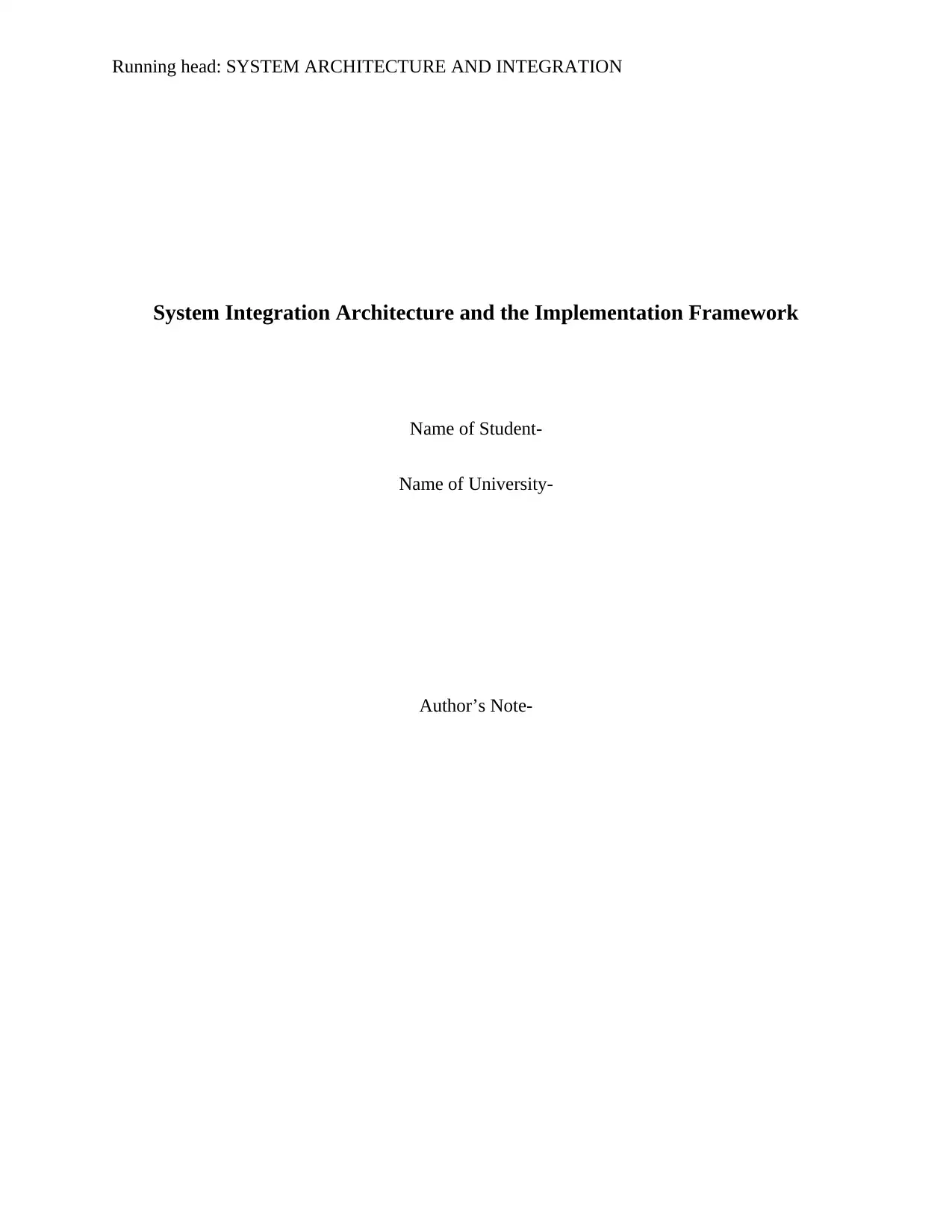
Running head: SYSTEM ARCHITECTURE AND INTEGRATION
System Integration Architecture and the Implementation Framework
Name of Student-
Name of University-
Author’s Note-
System Integration Architecture and the Implementation Framework
Name of Student-
Name of University-
Author’s Note-
Paraphrase This Document
Need a fresh take? Get an instant paraphrase of this document with our AI Paraphraser
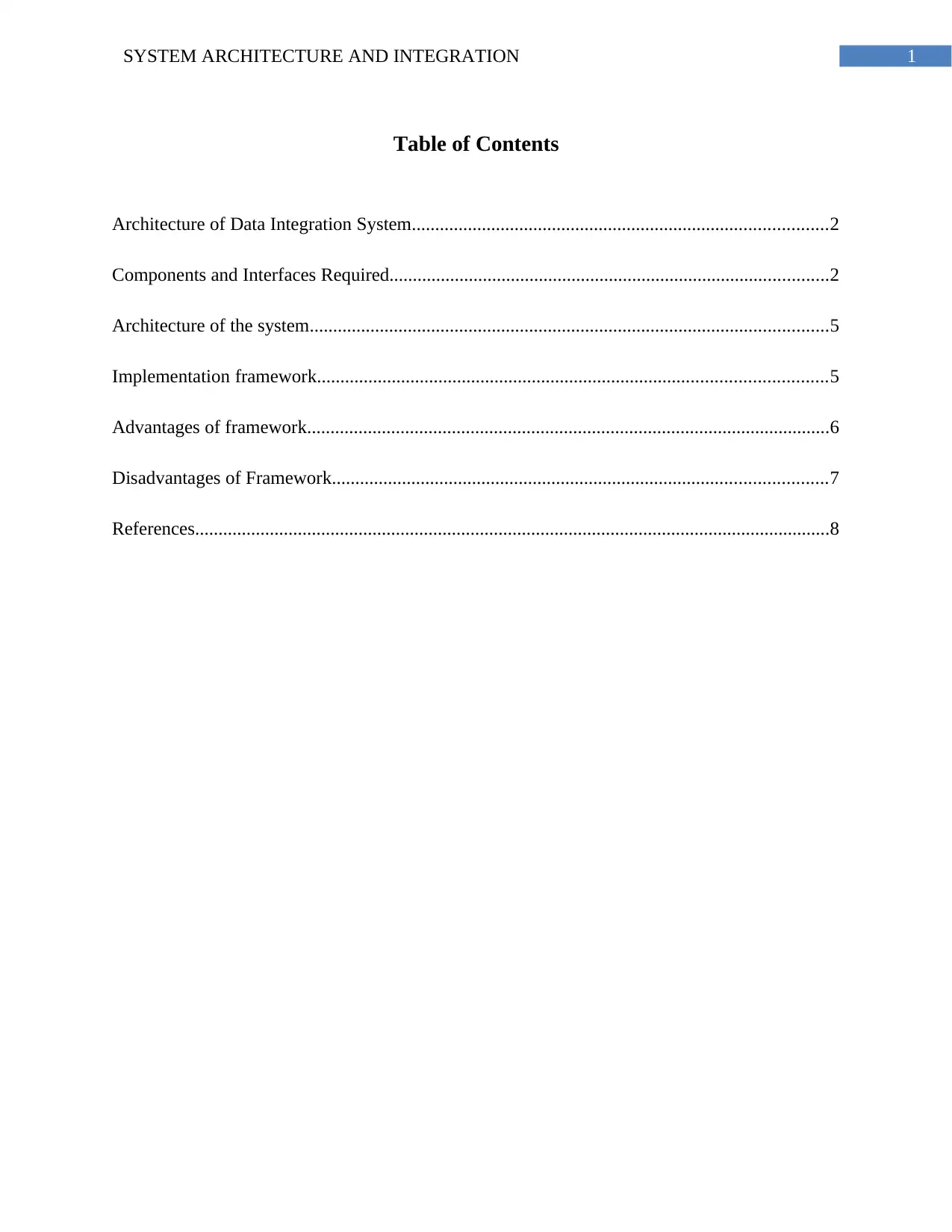
1SYSTEM ARCHITECTURE AND INTEGRATION
Table of Contents
Architecture of Data Integration System.........................................................................................2
Components and Interfaces Required..............................................................................................2
Architecture of the system...............................................................................................................5
Implementation framework.............................................................................................................5
Advantages of framework................................................................................................................6
Disadvantages of Framework..........................................................................................................7
References........................................................................................................................................8
Table of Contents
Architecture of Data Integration System.........................................................................................2
Components and Interfaces Required..............................................................................................2
Architecture of the system...............................................................................................................5
Implementation framework.............................................................................................................5
Advantages of framework................................................................................................................6
Disadvantages of Framework..........................................................................................................7
References........................................................................................................................................8
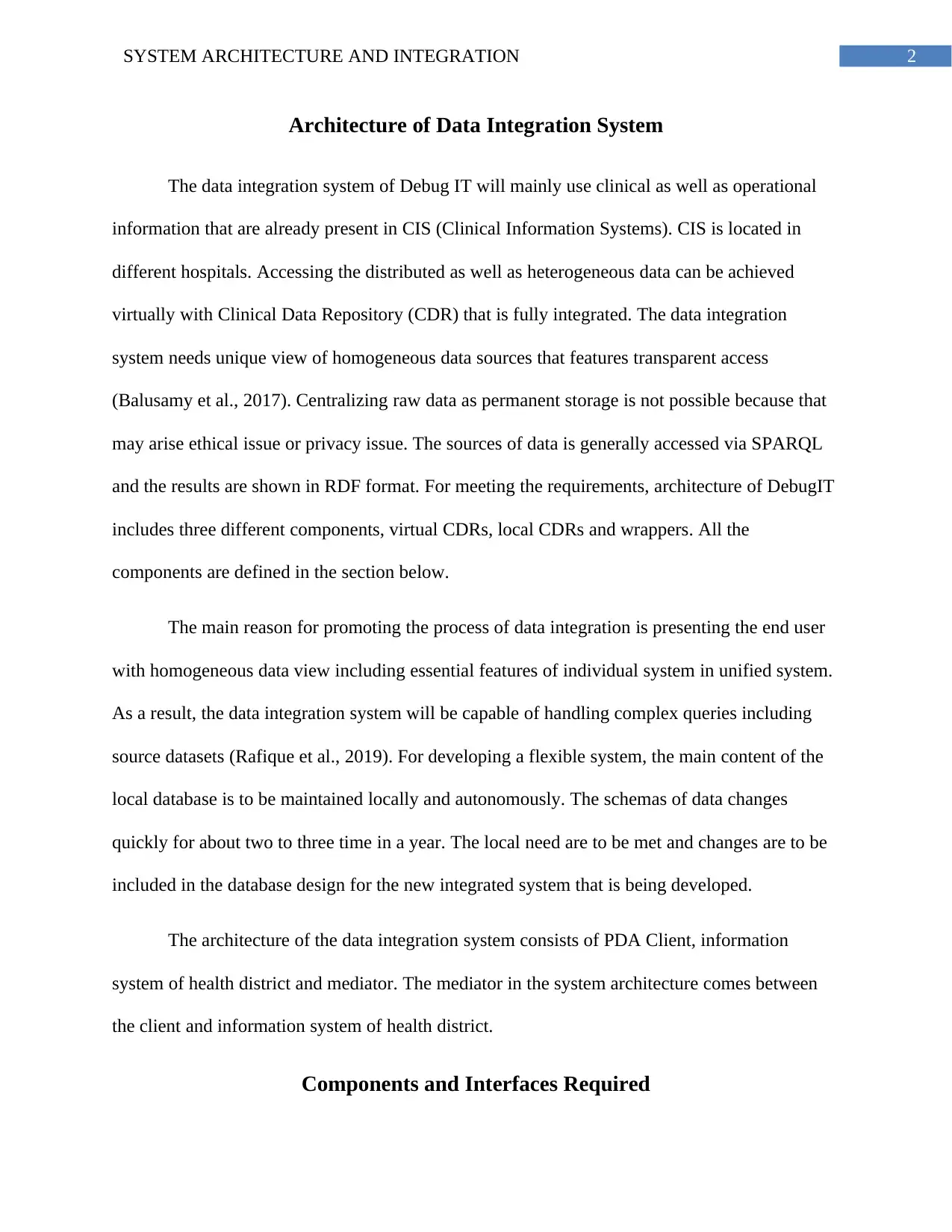
2SYSTEM ARCHITECTURE AND INTEGRATION
Architecture of Data Integration System
The data integration system of Debug IT will mainly use clinical as well as operational
information that are already present in CIS (Clinical Information Systems). CIS is located in
different hospitals. Accessing the distributed as well as heterogeneous data can be achieved
virtually with Clinical Data Repository (CDR) that is fully integrated. The data integration
system needs unique view of homogeneous data sources that features transparent access
(Balusamy et al., 2017). Centralizing raw data as permanent storage is not possible because that
may arise ethical issue or privacy issue. The sources of data is generally accessed via SPARQL
and the results are shown in RDF format. For meeting the requirements, architecture of DebugIT
includes three different components, virtual CDRs, local CDRs and wrappers. All the
components are defined in the section below.
The main reason for promoting the process of data integration is presenting the end user
with homogeneous data view including essential features of individual system in unified system.
As a result, the data integration system will be capable of handling complex queries including
source datasets (Rafique et al., 2019). For developing a flexible system, the main content of the
local database is to be maintained locally and autonomously. The schemas of data changes
quickly for about two to three time in a year. The local need are to be met and changes are to be
included in the database design for the new integrated system that is being developed.
The architecture of the data integration system consists of PDA Client, information
system of health district and mediator. The mediator in the system architecture comes between
the client and information system of health district.
Components and Interfaces Required
Architecture of Data Integration System
The data integration system of Debug IT will mainly use clinical as well as operational
information that are already present in CIS (Clinical Information Systems). CIS is located in
different hospitals. Accessing the distributed as well as heterogeneous data can be achieved
virtually with Clinical Data Repository (CDR) that is fully integrated. The data integration
system needs unique view of homogeneous data sources that features transparent access
(Balusamy et al., 2017). Centralizing raw data as permanent storage is not possible because that
may arise ethical issue or privacy issue. The sources of data is generally accessed via SPARQL
and the results are shown in RDF format. For meeting the requirements, architecture of DebugIT
includes three different components, virtual CDRs, local CDRs and wrappers. All the
components are defined in the section below.
The main reason for promoting the process of data integration is presenting the end user
with homogeneous data view including essential features of individual system in unified system.
As a result, the data integration system will be capable of handling complex queries including
source datasets (Rafique et al., 2019). For developing a flexible system, the main content of the
local database is to be maintained locally and autonomously. The schemas of data changes
quickly for about two to three time in a year. The local need are to be met and changes are to be
included in the database design for the new integrated system that is being developed.
The architecture of the data integration system consists of PDA Client, information
system of health district and mediator. The mediator in the system architecture comes between
the client and information system of health district.
Components and Interfaces Required
⊘ This is a preview!⊘
Do you want full access?
Subscribe today to unlock all pages.

Trusted by 1+ million students worldwide
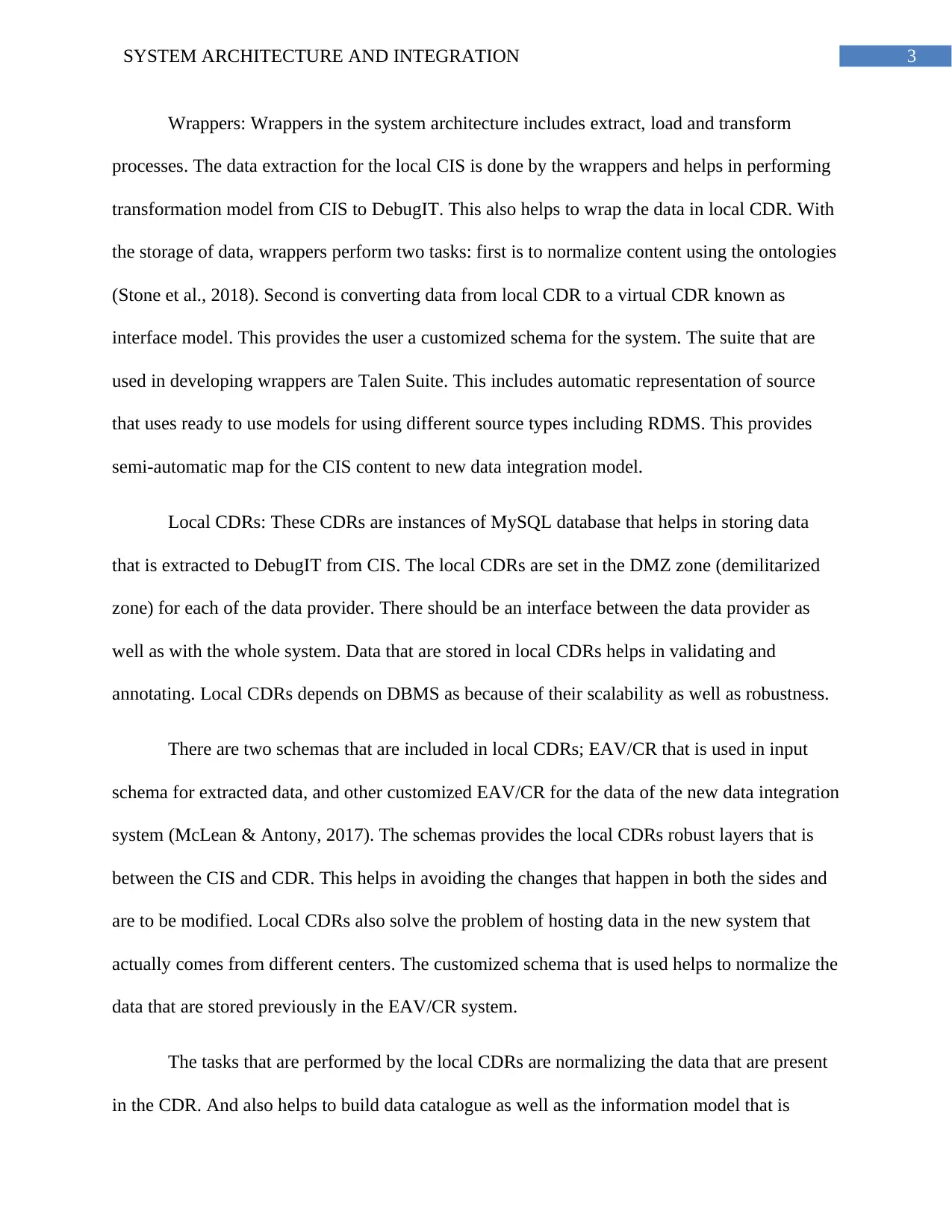
3SYSTEM ARCHITECTURE AND INTEGRATION
Wrappers: Wrappers in the system architecture includes extract, load and transform
processes. The data extraction for the local CIS is done by the wrappers and helps in performing
transformation model from CIS to DebugIT. This also helps to wrap the data in local CDR. With
the storage of data, wrappers perform two tasks: first is to normalize content using the ontologies
(Stone et al., 2018). Second is converting data from local CDR to a virtual CDR known as
interface model. This provides the user a customized schema for the system. The suite that are
used in developing wrappers are Talen Suite. This includes automatic representation of source
that uses ready to use models for using different source types including RDMS. This provides
semi-automatic map for the CIS content to new data integration model.
Local CDRs: These CDRs are instances of MySQL database that helps in storing data
that is extracted to DebugIT from CIS. The local CDRs are set in the DMZ zone (demilitarized
zone) for each of the data provider. There should be an interface between the data provider as
well as with the whole system. Data that are stored in local CDRs helps in validating and
annotating. Local CDRs depends on DBMS as because of their scalability as well as robustness.
There are two schemas that are included in local CDRs; EAV/CR that is used in input
schema for extracted data, and other customized EAV/CR for the data of the new data integration
system (McLean & Antony, 2017). The schemas provides the local CDRs robust layers that is
between the CIS and CDR. This helps in avoiding the changes that happen in both the sides and
are to be modified. Local CDRs also solve the problem of hosting data in the new system that
actually comes from different centers. The customized schema that is used helps to normalize the
data that are stored previously in the EAV/CR system.
The tasks that are performed by the local CDRs are normalizing the data that are present
in the CDR. And also helps to build data catalogue as well as the information model that is
Wrappers: Wrappers in the system architecture includes extract, load and transform
processes. The data extraction for the local CIS is done by the wrappers and helps in performing
transformation model from CIS to DebugIT. This also helps to wrap the data in local CDR. With
the storage of data, wrappers perform two tasks: first is to normalize content using the ontologies
(Stone et al., 2018). Second is converting data from local CDR to a virtual CDR known as
interface model. This provides the user a customized schema for the system. The suite that are
used in developing wrappers are Talen Suite. This includes automatic representation of source
that uses ready to use models for using different source types including RDMS. This provides
semi-automatic map for the CIS content to new data integration model.
Local CDRs: These CDRs are instances of MySQL database that helps in storing data
that is extracted to DebugIT from CIS. The local CDRs are set in the DMZ zone (demilitarized
zone) for each of the data provider. There should be an interface between the data provider as
well as with the whole system. Data that are stored in local CDRs helps in validating and
annotating. Local CDRs depends on DBMS as because of their scalability as well as robustness.
There are two schemas that are included in local CDRs; EAV/CR that is used in input
schema for extracted data, and other customized EAV/CR for the data of the new data integration
system (McLean & Antony, 2017). The schemas provides the local CDRs robust layers that is
between the CIS and CDR. This helps in avoiding the changes that happen in both the sides and
are to be modified. Local CDRs also solve the problem of hosting data in the new system that
actually comes from different centers. The customized schema that is used helps to normalize the
data that are stored previously in the EAV/CR system.
The tasks that are performed by the local CDRs are normalizing the data that are present
in the CDR. And also helps to build data catalogue as well as the information model that is
Paraphrase This Document
Need a fresh take? Get an instant paraphrase of this document with our AI Paraphraser
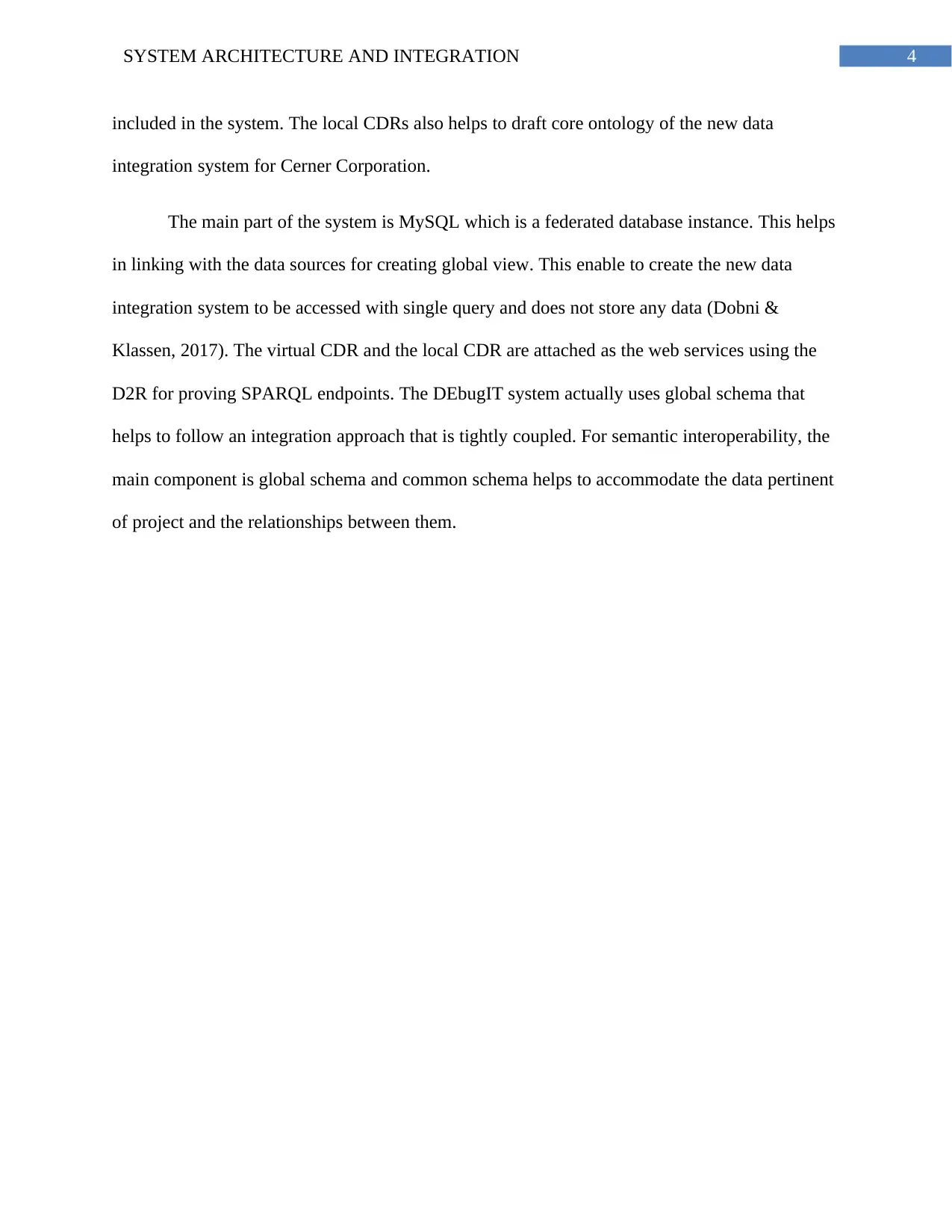
4SYSTEM ARCHITECTURE AND INTEGRATION
included in the system. The local CDRs also helps to draft core ontology of the new data
integration system for Cerner Corporation.
The main part of the system is MySQL which is a federated database instance. This helps
in linking with the data sources for creating global view. This enable to create the new data
integration system to be accessed with single query and does not store any data (Dobni &
Klassen, 2017). The virtual CDR and the local CDR are attached as the web services using the
D2R for proving SPARQL endpoints. The DEbugIT system actually uses global schema that
helps to follow an integration approach that is tightly coupled. For semantic interoperability, the
main component is global schema and common schema helps to accommodate the data pertinent
of project and the relationships between them.
included in the system. The local CDRs also helps to draft core ontology of the new data
integration system for Cerner Corporation.
The main part of the system is MySQL which is a federated database instance. This helps
in linking with the data sources for creating global view. This enable to create the new data
integration system to be accessed with single query and does not store any data (Dobni &
Klassen, 2017). The virtual CDR and the local CDR are attached as the web services using the
D2R for proving SPARQL endpoints. The DEbugIT system actually uses global schema that
helps to follow an integration approach that is tightly coupled. For semantic interoperability, the
main component is global schema and common schema helps to accommodate the data pertinent
of project and the relationships between them.
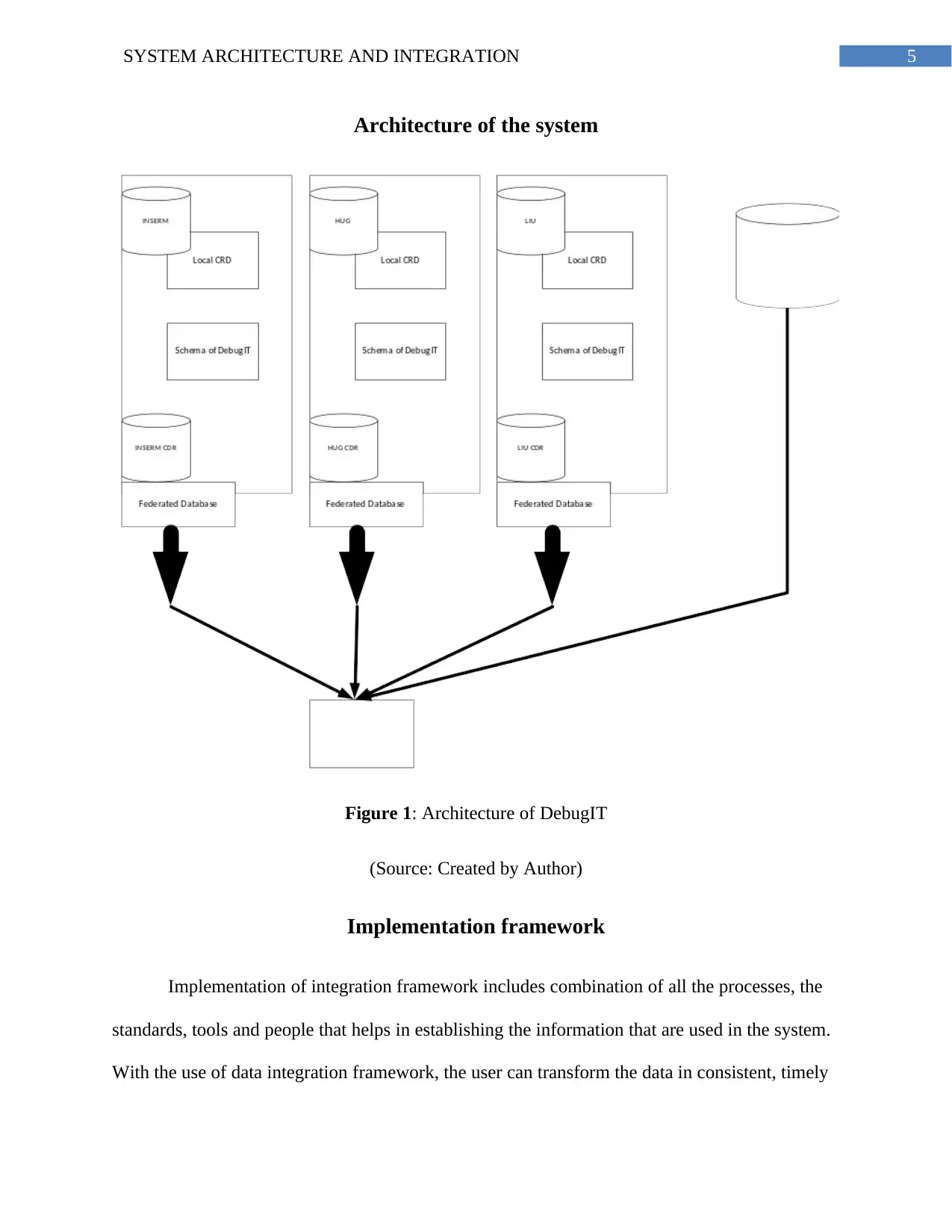
5SYSTEM ARCHITECTURE AND INTEGRATION
Architecture of the system
Figure 1: Architecture of DebugIT
(Source: Created by Author)
Implementation framework
Implementation of integration framework includes combination of all the processes, the
standards, tools and people that helps in establishing the information that are used in the system.
With the use of data integration framework, the user can transform the data in consistent, timely
Architecture of the system
Figure 1: Architecture of DebugIT
(Source: Created by Author)
Implementation framework
Implementation of integration framework includes combination of all the processes, the
standards, tools and people that helps in establishing the information that are used in the system.
With the use of data integration framework, the user can transform the data in consistent, timely
⊘ This is a preview!⊘
Do you want full access?
Subscribe today to unlock all pages.

Trusted by 1+ million students worldwide
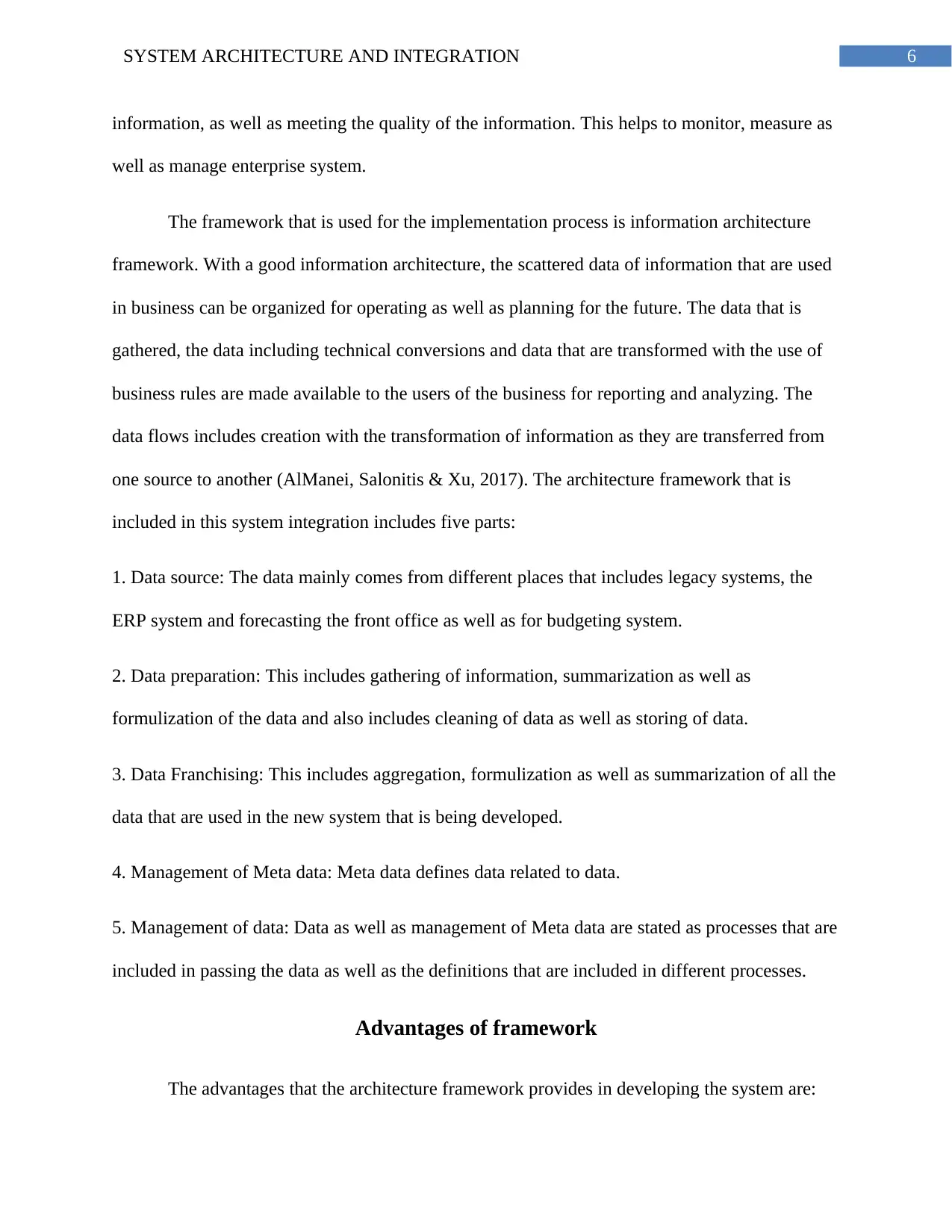
6SYSTEM ARCHITECTURE AND INTEGRATION
information, as well as meeting the quality of the information. This helps to monitor, measure as
well as manage enterprise system.
The framework that is used for the implementation process is information architecture
framework. With a good information architecture, the scattered data of information that are used
in business can be organized for operating as well as planning for the future. The data that is
gathered, the data including technical conversions and data that are transformed with the use of
business rules are made available to the users of the business for reporting and analyzing. The
data flows includes creation with the transformation of information as they are transferred from
one source to another (AlManei, Salonitis & Xu, 2017). The architecture framework that is
included in this system integration includes five parts:
1. Data source: The data mainly comes from different places that includes legacy systems, the
ERP system and forecasting the front office as well as for budgeting system.
2. Data preparation: This includes gathering of information, summarization as well as
formulization of the data and also includes cleaning of data as well as storing of data.
3. Data Franchising: This includes aggregation, formulization as well as summarization of all the
data that are used in the new system that is being developed.
4. Management of Meta data: Meta data defines data related to data.
5. Management of data: Data as well as management of Meta data are stated as processes that are
included in passing the data as well as the definitions that are included in different processes.
Advantages of framework
The advantages that the architecture framework provides in developing the system are:
information, as well as meeting the quality of the information. This helps to monitor, measure as
well as manage enterprise system.
The framework that is used for the implementation process is information architecture
framework. With a good information architecture, the scattered data of information that are used
in business can be organized for operating as well as planning for the future. The data that is
gathered, the data including technical conversions and data that are transformed with the use of
business rules are made available to the users of the business for reporting and analyzing. The
data flows includes creation with the transformation of information as they are transferred from
one source to another (AlManei, Salonitis & Xu, 2017). The architecture framework that is
included in this system integration includes five parts:
1. Data source: The data mainly comes from different places that includes legacy systems, the
ERP system and forecasting the front office as well as for budgeting system.
2. Data preparation: This includes gathering of information, summarization as well as
formulization of the data and also includes cleaning of data as well as storing of data.
3. Data Franchising: This includes aggregation, formulization as well as summarization of all the
data that are used in the new system that is being developed.
4. Management of Meta data: Meta data defines data related to data.
5. Management of data: Data as well as management of Meta data are stated as processes that are
included in passing the data as well as the definitions that are included in different processes.
Advantages of framework
The advantages that the architecture framework provides in developing the system are:
Paraphrase This Document
Need a fresh take? Get an instant paraphrase of this document with our AI Paraphraser
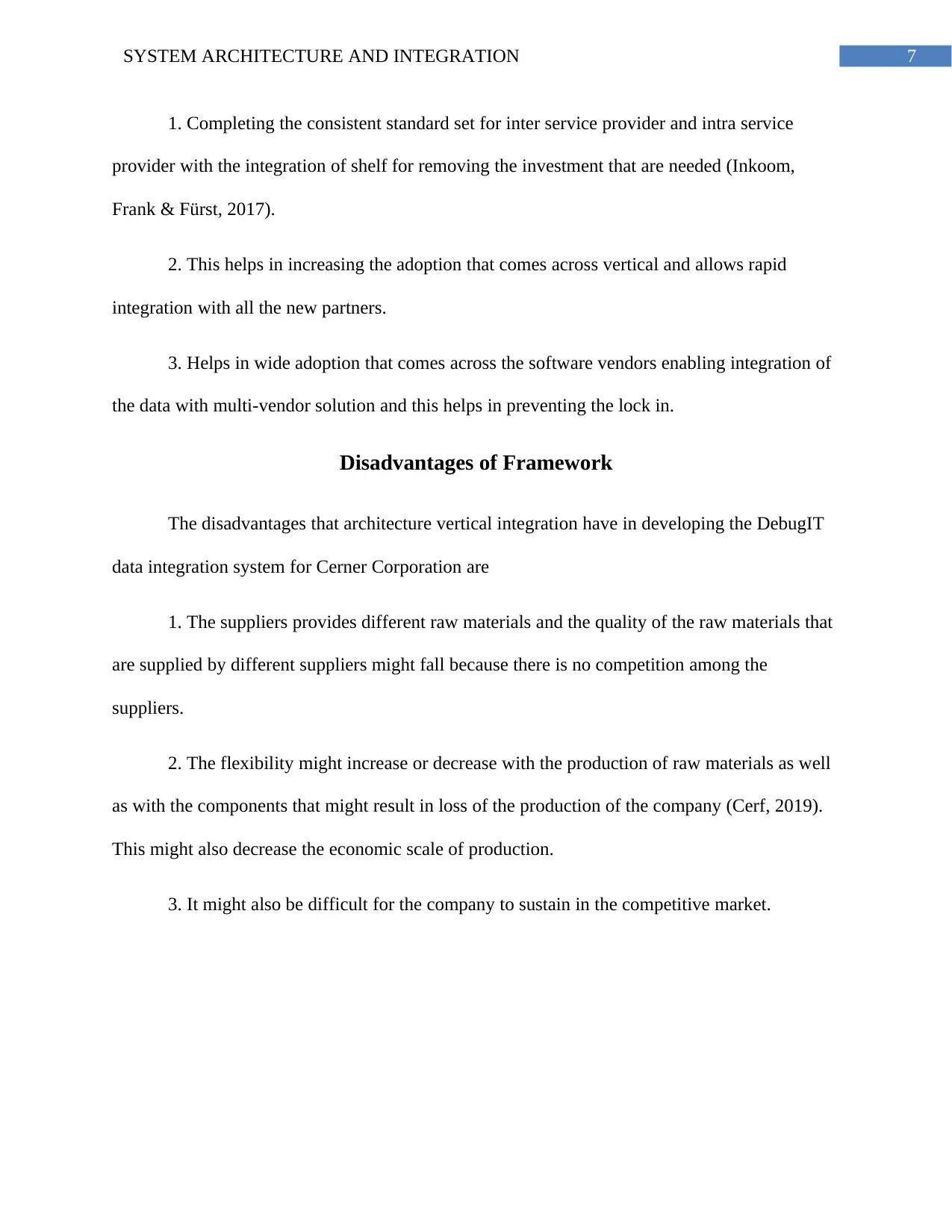
7SYSTEM ARCHITECTURE AND INTEGRATION
1. Completing the consistent standard set for inter service provider and intra service
provider with the integration of shelf for removing the investment that are needed (Inkoom,
Frank & Fürst, 2017).
2. This helps in increasing the adoption that comes across vertical and allows rapid
integration with all the new partners.
3. Helps in wide adoption that comes across the software vendors enabling integration of
the data with multi-vendor solution and this helps in preventing the lock in.
Disadvantages of Framework
The disadvantages that architecture vertical integration have in developing the DebugIT
data integration system for Cerner Corporation are
1. The suppliers provides different raw materials and the quality of the raw materials that
are supplied by different suppliers might fall because there is no competition among the
suppliers.
2. The flexibility might increase or decrease with the production of raw materials as well
as with the components that might result in loss of the production of the company (Cerf, 2019).
This might also decrease the economic scale of production.
3. It might also be difficult for the company to sustain in the competitive market.
1. Completing the consistent standard set for inter service provider and intra service
provider with the integration of shelf for removing the investment that are needed (Inkoom,
Frank & Fürst, 2017).
2. This helps in increasing the adoption that comes across vertical and allows rapid
integration with all the new partners.
3. Helps in wide adoption that comes across the software vendors enabling integration of
the data with multi-vendor solution and this helps in preventing the lock in.
Disadvantages of Framework
The disadvantages that architecture vertical integration have in developing the DebugIT
data integration system for Cerner Corporation are
1. The suppliers provides different raw materials and the quality of the raw materials that
are supplied by different suppliers might fall because there is no competition among the
suppliers.
2. The flexibility might increase or decrease with the production of raw materials as well
as with the components that might result in loss of the production of the company (Cerf, 2019).
This might also decrease the economic scale of production.
3. It might also be difficult for the company to sustain in the competitive market.
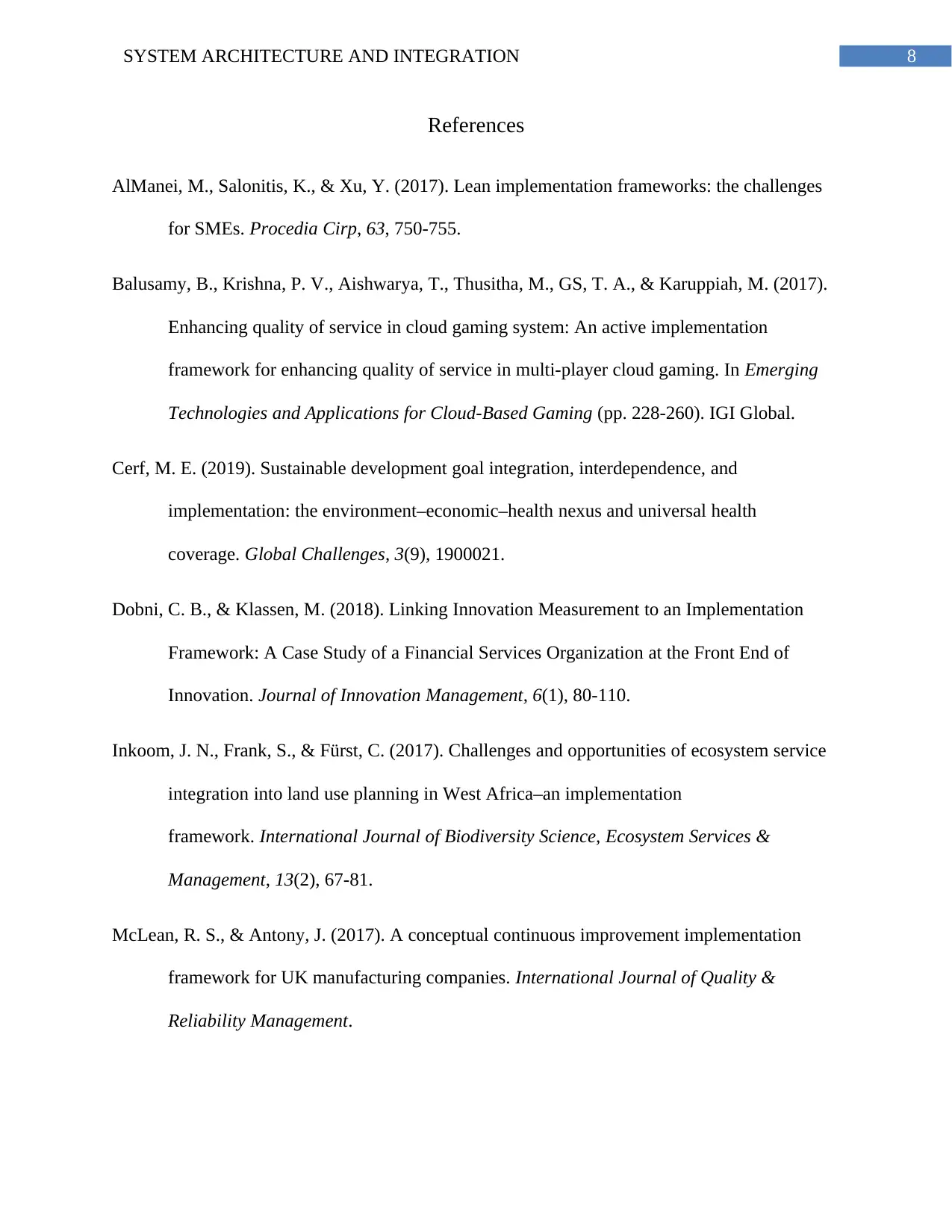
8SYSTEM ARCHITECTURE AND INTEGRATION
References
AlManei, M., Salonitis, K., & Xu, Y. (2017). Lean implementation frameworks: the challenges
for SMEs. Procedia Cirp, 63, 750-755.
Balusamy, B., Krishna, P. V., Aishwarya, T., Thusitha, M., GS, T. A., & Karuppiah, M. (2017).
Enhancing quality of service in cloud gaming system: An active implementation
framework for enhancing quality of service in multi-player cloud gaming. In Emerging
Technologies and Applications for Cloud-Based Gaming (pp. 228-260). IGI Global.
Cerf, M. E. (2019). Sustainable development goal integration, interdependence, and
implementation: the environment–economic–health nexus and universal health
coverage. Global Challenges, 3(9), 1900021.
Dobni, C. B., & Klassen, M. (2018). Linking Innovation Measurement to an Implementation
Framework: A Case Study of a Financial Services Organization at the Front End of
Innovation. Journal of Innovation Management, 6(1), 80-110.
Inkoom, J. N., Frank, S., & Fürst, C. (2017). Challenges and opportunities of ecosystem service
integration into land use planning in West Africa–an implementation
framework. International Journal of Biodiversity Science, Ecosystem Services &
Management, 13(2), 67-81.
McLean, R. S., & Antony, J. (2017). A conceptual continuous improvement implementation
framework for UK manufacturing companies. International Journal of Quality &
Reliability Management.
References
AlManei, M., Salonitis, K., & Xu, Y. (2017). Lean implementation frameworks: the challenges
for SMEs. Procedia Cirp, 63, 750-755.
Balusamy, B., Krishna, P. V., Aishwarya, T., Thusitha, M., GS, T. A., & Karuppiah, M. (2017).
Enhancing quality of service in cloud gaming system: An active implementation
framework for enhancing quality of service in multi-player cloud gaming. In Emerging
Technologies and Applications for Cloud-Based Gaming (pp. 228-260). IGI Global.
Cerf, M. E. (2019). Sustainable development goal integration, interdependence, and
implementation: the environment–economic–health nexus and universal health
coverage. Global Challenges, 3(9), 1900021.
Dobni, C. B., & Klassen, M. (2018). Linking Innovation Measurement to an Implementation
Framework: A Case Study of a Financial Services Organization at the Front End of
Innovation. Journal of Innovation Management, 6(1), 80-110.
Inkoom, J. N., Frank, S., & Fürst, C. (2017). Challenges and opportunities of ecosystem service
integration into land use planning in West Africa–an implementation
framework. International Journal of Biodiversity Science, Ecosystem Services &
Management, 13(2), 67-81.
McLean, R. S., & Antony, J. (2017). A conceptual continuous improvement implementation
framework for UK manufacturing companies. International Journal of Quality &
Reliability Management.
⊘ This is a preview!⊘
Do you want full access?
Subscribe today to unlock all pages.

Trusted by 1+ million students worldwide
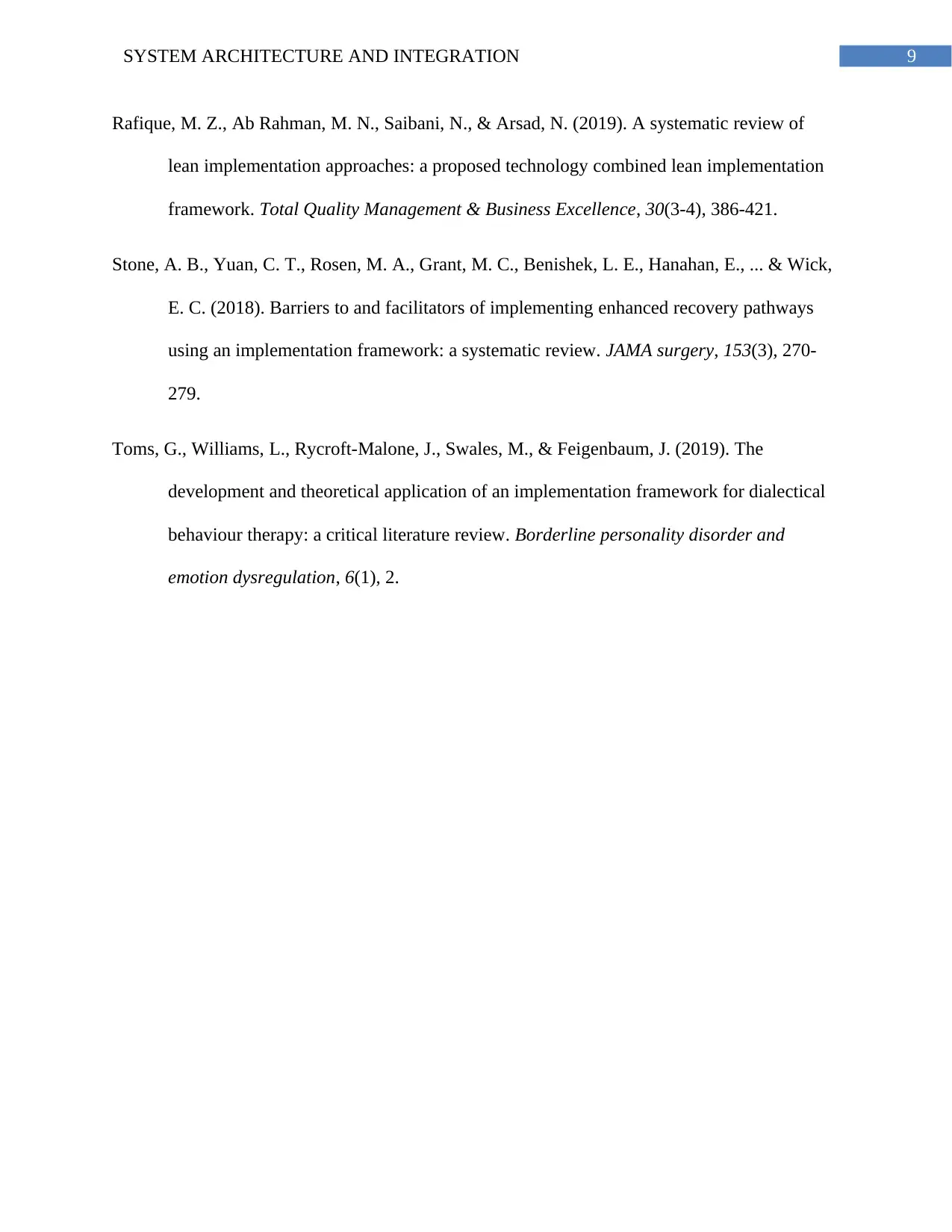
9SYSTEM ARCHITECTURE AND INTEGRATION
Rafique, M. Z., Ab Rahman, M. N., Saibani, N., & Arsad, N. (2019). A systematic review of
lean implementation approaches: a proposed technology combined lean implementation
framework. Total Quality Management & Business Excellence, 30(3-4), 386-421.
Stone, A. B., Yuan, C. T., Rosen, M. A., Grant, M. C., Benishek, L. E., Hanahan, E., ... & Wick,
E. C. (2018). Barriers to and facilitators of implementing enhanced recovery pathways
using an implementation framework: a systematic review. JAMA surgery, 153(3), 270-
279.
Toms, G., Williams, L., Rycroft-Malone, J., Swales, M., & Feigenbaum, J. (2019). The
development and theoretical application of an implementation framework for dialectical
behaviour therapy: a critical literature review. Borderline personality disorder and
emotion dysregulation, 6(1), 2.
Rafique, M. Z., Ab Rahman, M. N., Saibani, N., & Arsad, N. (2019). A systematic review of
lean implementation approaches: a proposed technology combined lean implementation
framework. Total Quality Management & Business Excellence, 30(3-4), 386-421.
Stone, A. B., Yuan, C. T., Rosen, M. A., Grant, M. C., Benishek, L. E., Hanahan, E., ... & Wick,
E. C. (2018). Barriers to and facilitators of implementing enhanced recovery pathways
using an implementation framework: a systematic review. JAMA surgery, 153(3), 270-
279.
Toms, G., Williams, L., Rycroft-Malone, J., Swales, M., & Feigenbaum, J. (2019). The
development and theoretical application of an implementation framework for dialectical
behaviour therapy: a critical literature review. Borderline personality disorder and
emotion dysregulation, 6(1), 2.
1 out of 10
Related Documents
Your All-in-One AI-Powered Toolkit for Academic Success.
+13062052269
info@desklib.com
Available 24*7 on WhatsApp / Email
![[object Object]](/_next/static/media/star-bottom.7253800d.svg)
Unlock your academic potential
Copyright © 2020–2025 A2Z Services. All Rights Reserved. Developed and managed by ZUCOL.



